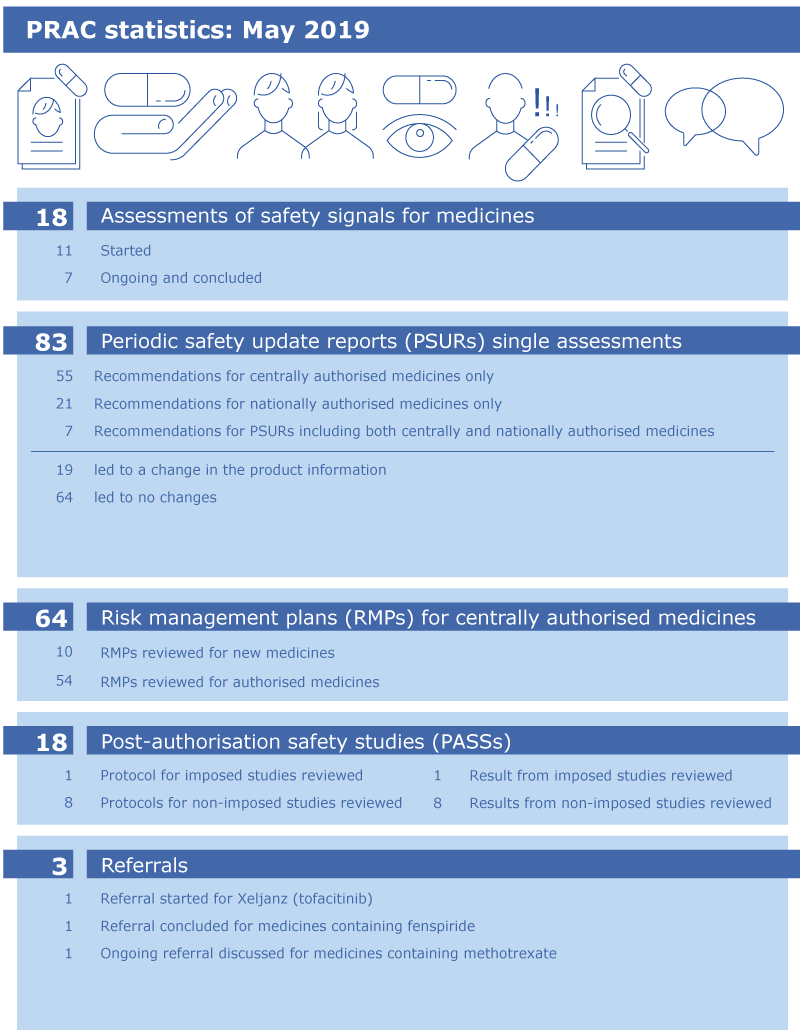Meeting highlights from the Pharmacovigilance Risk Assessment Committee (PRAC) 13-16 May 2019
NewsHumanMedicinesPharmacovigilance
EMA’s safety committee (PRAC) has started a new review of Xeljanz (tofacitinib) and has recommended, as a temporary measure during the review, that doctors must not prescribe the 10 mg twice-daily dose of this medicine in patients who are at high risk of blood clots in the lungs. These include patients who have heart failure, cancer, inherited blood clotting disorders or a history of blood clots, as well as patients who take combined hormonal contraceptives, are receiving hormone replacement therapy or are undergoing major surgery.
The PRAC’s recommendation follows results from an ongoing study in patients with rheumatoid arthritis, which showed an increased risk of blood clots in the lungs and death when the 10 mg twice daily dose was used.
The PRAC will now carry out a review of all available evidence, and updated guidance will be provided to patients and healthcare professionals once the review is concluded.
More information is available below.
The PRAC has recommended that the marketing authorisations for cough medicines containing fenspiride be revoked, so they can no longer be marketed in the European Union. This follows a review that has confirmed that fenspiride medicines could cause heart rhythm problems.
In its review, the PRAC considered all the available evidence, such as cases of QT prolongation and torsades de pointes (abnormalities of the heart’s electrical activity that may lead to heart rhythm disturbances) in patients using these medicines, results of laboratory studies, data from published literature and stakeholder input.
Healthcare professionals should no longer prescribe fenspiride medicines and should advise their patients to stop taking them. Patients are advised to stop taking these medicines and contact their doctor or pharmacist for advice on alternative treatments, if needed.
More information is available below.
From now onwards, a monthly infographic of PRAC’s activity will be published on EMA’s website. The infographic presents the total number of procedures discussed during each PRAC meeting, as captured and detailed in the meeting agenda. The PRAC’s broad range of responsibilities cover all aspects of the risk management of medicines throughout their lifecycle: assessment of signals, periodic safety update reports, risk management plans, post-authorisation safety studies and referrals. These terms are explained below:
The 1,500th study has been uploaded in the EU electronic Register of Post-Authorisation Studies (EU PAS Register).
The EU PAS Register provides a wealth of information on the safety and effectiveness of authorised medicines. It is an openly accessible platform with information on post authorisation research in medicines already marketed in Europe and includes study protocols, study results, related publications and other relevant information.
The information in the EU PAS Register helps to reduce publication bias (when a study outcome influences the decision whether to publish or otherwise distribute it) through increased transparency of medicines research, improves the quality of post-authorisation studies by facilitating peer-review of protocols and results, facilitates collaboration among stakeholders, and ensures compliance with EU pharmacovigilance legislation requirements.
The EU PAS Register was developed through the European Network of Centres for Pharmacoepidemiology and Pharmacovigilance (ENCePP), which is coordinated by EMA to support research in pharmacoepidemiology and pharmacovigilance.

|
Procedure |
Status |
Update |
|---|---|---|
|
Article-31 procedure: Estradiol-containing (0.01% w/w) medicinal products for topical use |
Under evaluation |
PRAC continued its assessment |
|
Article-31 procedure: Fluorouracil and fluorouracil related substances (capecitabine, tegafur and flucytosine) containing medicinal products |
Under evaluation |
PRAC continued its assessment |
|
Article-20 procedure: Lemtrada |
Under evaluation |
PRAC continued its assessment |
|
Article-31 procedure: Methotrexate containing medicinal products |
Under evaluation |
PRAC adopted a list of outstanding issues |